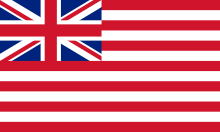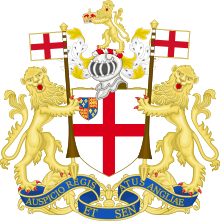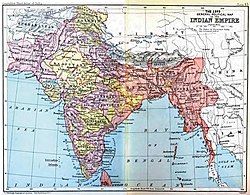East India Company's

|
|

Coat of arms (1698)
|
|
| Industry | International trade |
|---|---|
| Fate | Dissolved, after being mostly nationalised in 1858 |
| Founded | 31 December 1600 |
| Founders | John Watts, George White |
| Defunct | 1 June 1874 |
| Headquarters | London, England (Great Britain) |

Imperial entities of India
|
|
| Dutch India | 1605–1825 |
|---|---|
| Danish India | 1620–1869 |
| French India | 1668–1954 |
|
|
|
| Casa da Índia | 1434–1833 |
| Portuguese East India Company | 1628–1633 |
|
|
|
| East India Company | 1612–1757 |
| Company rule in India | 1757–1858 |
| British Raj | 1858–1947 |
| British rule in Burma | 1824–1948 |
| Princely states | 1721–1949 |
| Partition of India |
1947
|
|
|
|
The East India Company (EIC), also known as the Honourable East India Company (HEIC) or the British East India Company and informally as John Company, was an English and later British , formed to trade with the East Indies (in present-day terms, Maritime Southeast Asia), but ended up trading mainly with Qing China and seizing control of large parts of the Indian subcontinent.
Originally chartered as the "Governor and Company of Merchants of London trading into the East Indies", the company rose to account for half of the world's trade, particularly in basic commodities including cotton, silk, indigo dye, salt, saltpetre, tea, and opium. The company also ruled the beginnings of the British Empire in India.
The company received a Royal Charter from Queen Elizabeth I on 31 December 1600, coming relatively late to trade in the Indies. Before them the Portuguese Estado da Índia had traded there for much of the 16th century and the first of half a dozen Dutch Companies sailed to trade there from 1595, which amalgamated in March 1602 into the United East Indies Company (VOC), which introduced the first permanent joint stock from 1612 (meaning investment into shares did not need to be returned, but could be traded on a stock exchange). Wealthy merchants and owned the EIC's shares. Initially the government owned no shares and had only indirect control until 1657 when permanent joint stock was established.
During its first century of operation, the focus of the company was trade, not the building of an empire in India. Company interests turned from trade to territory during the 18th century as the Mughal Empire declined in power and the East India Company struggled with its French counterpart, the French East India Company (Compagnie française des Indes orientales) during the Carnatic Wars of the 1740s and 1750s. The battles of Plassey and Buxar, in which the British defeated the Bengali powers, left the company in control of Bengal and a major military and political power in India. In the following decades it gradually increased the extent of the territories under its control, controlling the majority of the Indian subcontinent either directly or indirectly via local puppet rulers under the threat of force by its Presidency armies, much of which were composed of native Indian sepoys.
...
Wikipedia
